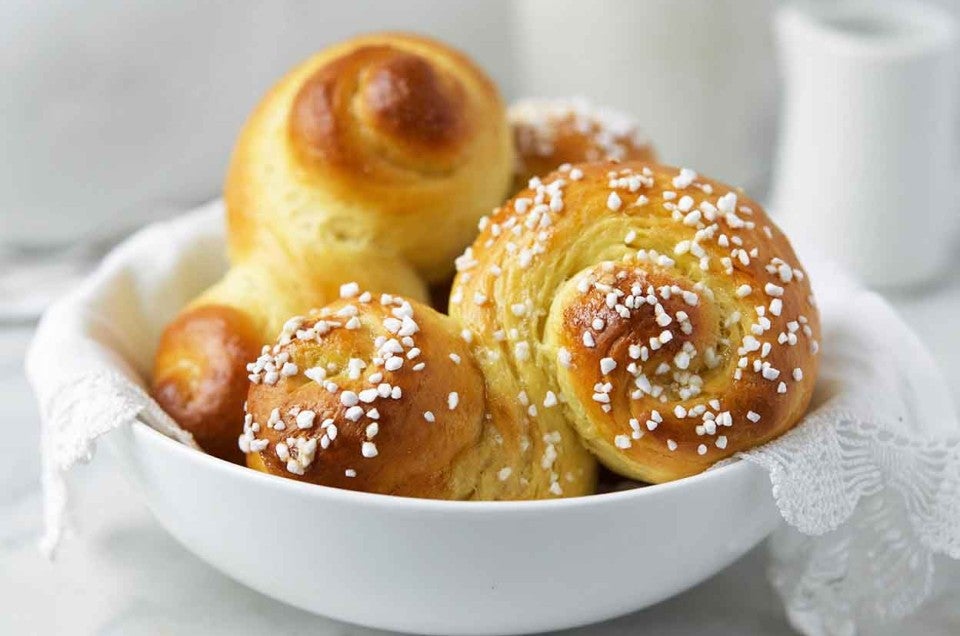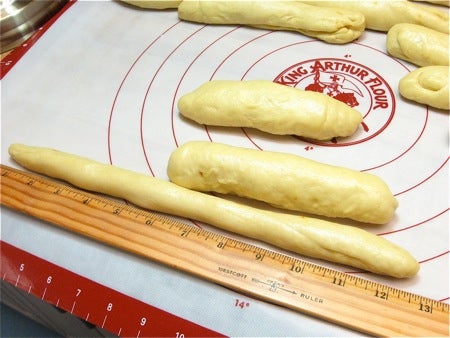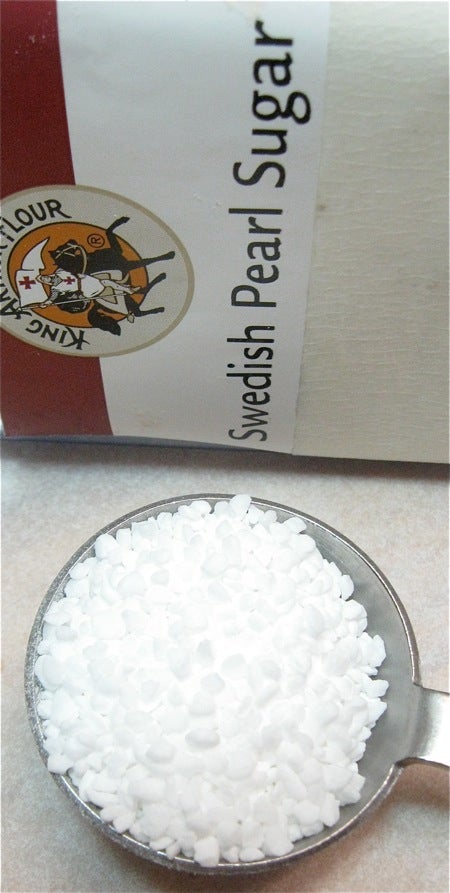


Have you crashed into the Sugar Wall yet?
You know, that point sometime between Thanksgiving and Christmas when you've FINALLY had your fill of cookies and fruitcake, candy and rich pastries, and are ready for, oh, a piece of bread and butter, or a bowl of Rice Chex (preferably NOT in the form of Party Mix)?
I reach that wall very early; I always gravitate more towards the savory side, and December is no exception. A couple of cookies, a piece of candy – I'm good. Bring on the cheese and crackers.
And when I want something sweet, I'm perfectly happy with dried apricots, or one of those last Golden Russet apples from the local orchard.
Still, I realize Christmas is ALL about sweets – except when it's not... quite.
As in the case of St. Lucia Day, celebrated each year on December 13 – the shortest day (longest night) of the year, according to the ancient (Julian) calendar in force when Lucy/Lucia was martyred in 304 A.D.
Scotland and other northern European countries have a history of marking the year's longest night with bonfires, built to encourage the return of the sun. Thus it's no surprise that St. Lucia Day is celebrated in Scandinavia. This feast day is associated most strongly with Sweden; but Norway, Finland, Denmark, and Iceland also observe the day, as do Estonia, Latvia, Italy, Croatia, Bavaria, and Bosnia.
St. Lucia celebrations include a procession of young girls in white dresses carrying candles. Most of the girls carry a single candle, but the girl chosen to represent Lucia wears an entire crown of lit candles, and carries a tray of golden, saffron-scented St. Lucia Buns.

And boy, did we get in hot water when, 10 years ago, we pictured our own St. Lucia on one of our Baker's Catalogue covers.
“How DARE you endanger that child for the sake of commerce!”
“WHAT were you thinking?!”
Well, we were thinking that Althea, the granddaughter of King Arthur's long-time owners, Frank and Brinna Sands, would be perfectly safe under the very careful ministrations of our catalogue photographer, John Sherman.
In fact, Althea is now a college senior, has traveled the world and, like many a 21-year-old, has done WAY more outrageous things than wear a crown of lit candles - just ask her mom, who works at our Baker's Store here in Vermont.

Ten years later ... Althea (on the left), with her roommate, Hannah, and St. Lucia buns. As Brinna (her grandmother) says, “Still tempting fate:-)”
Ready to celebrate St. Lucia Day? While the candle crown is optional, these St. Lucia Buns are a must-have.
Saffron is a key ingredient in St. Lucia Buns – and it's the world's most expensive spice. Luckily, a little goes a long way.
And what exactly is saffron? It's the little fronds inside the flower of a crocus native to southwest Asia. Its flavor is distinctive, but it's often used more for the brilliant gold color it adds to baked goods.
You can usually find saffron in tiny little vials or packets in the spice section of better supermarkets.
1/4 teaspoon saffron threads is plenty to color and flavor our buns.
In a small saucepan set over medium heat (or easier, in the microwave), heat 1 cup (227g) milk and the saffron to a simmer.
Remove from the heat, and stir to combine.
Add 8 tablespoons (113g) butter, cut into pats.
Set the mixture aside to allow the butter to melt, and for it to cool to lukewarm, 30 to 35 minutes. You can reduce the milk's cooling time by about 10 minutes by refrigerating it.
104°F or thereabouts is just about right.
Place the following in a mixing bowl:
4 1/2 cups (539g) King Arthur Unbleached All-Purpose Flour
1 tablespoon instant yeast
1/4 cup (43g) potato flour or 1/2 cup (43g) dried potato flakes
1 1/2 teaspoons salt*
1/3 cup (67g) granulated sugar
Add the lukewarm milk/saffron.
Add the 2 large whole eggs, and 1 large egg yolk; reserve the white for later.
Mix to combine.
Knead for about 7 minutes by mixer, about 10 minutes by hand, until the dough is smooth and supple. It'll remain fairly sticky; that's OK. The dough above has been kneaded for about 4 minutes.
When kneading sticky dough in a stand mixer, it helps to stop midway through, scrape down the sides of the bowl, then continue.
Here's the dough after 7 minutes of kneading.
Place the dough in a lightly greased bowl or large (8-cup) measuring cup, cover it, and let it rise for 1 hour, or until it's quite puffy, though not necessarily doubled in bulk.
The dough has risen to about half again its size; that's fine. This dough, with its high sugar and fat content, isn't a vigorous riser.
Gently deflate the dough, and divide it into 12 equal pieces. A scale makes this job easy; divide the dough in half, then in half again, then in thirds.
Each piece will weigh about 92g, or 3 1/4 ounces.
Shape the pieces of dough into rough logs; you can see the ones in the front have been shaped. Let them rest, covered, for about 10 minutes; this gives the gluten a chance to relax.
You're going to roll one piece of dough at a time into a long rope. A lightly greased silicone rolling mat is a big help here.
Start by flattening the log, and folding it over on itself.
Flatten again, and fold it over again. As you go through this process, the dough will elongate on its own.
Put the seam side on the bottom, and set the log aside while you work on the others.
Once you've got all 12 this far, it's time to roll them out to their final length.
Why not just roll each one to the desired length right away, without this interim step? Because it's a lot easier to stretch and roll dough if you've given its gluten a chance to relax.
Gluten needs to be coaxed; it can't be bullied. If you've ever rolled a pizza crust that kept shrinking down smaller and smaller the harder and harder you rolled it, you know what I mean!
Roll each log into a 15” to 18” rope; your final goal is around 13”, and the ropes will shrink down to that once you stop rolling.
Shape each rope into an “S” shape by curling the ends in opposite directions.
Like this.
Space the rolls in a lightly greased or parchment-lined baking sheet.
Tuck a golden raisin into the center of each of the two side-by-side coils, if desired.
Cover the buns, and let them rise for about 30 minutes, until they're noticeably puffy, but definitely not doubled.
While they're rising, preheat the oven to 375°F.
Notice how puffy they've gotten – rich yeast rolls, those high in fat and sugar, have a difficult time rising, so this is good!
Mix the reserved egg white with 1 tablespoon cold water, and brush on the buns.
Here's a nice crowning touch for these Scandinavian buns: Swedish pearl sugar, a bright white, coarse sugar that doesn't melt in the oven.
Sprinkle the buns generously with pearl sugar, if desired.
Bake the buns until they're golden brown, about 18 to 20 minutes.
If you've used raisins, tent the buns with foil for the final 3 minutes, to prevent the raisins from burning.
Remove the buns from the oven, and cool them right on the pan; or transfer to a rack.
See what I mean about saffron? Amazing color!
Imagine these as they're served in Sweden – on a platter, being carried through a candle-lit room by a lovely young girl wearing a crown. Happy St. Lucia day!
Read, rate, and review (please) our recipe for St. Lucia Buns.





































